Fantasyland of gifts provides a profitable setting for bakery foods
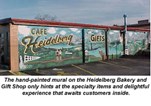
The Heidelberg Bakery Cafe and Gift Shop literally has something for everyone.
By Carol Meres Kroskey, baker-editor
Contents
Cafe seating helps to sell bakery foods
Gifts galore make bakery visits fun
Antique bakery provides a glimpse into the past
First-time customers who stop in at the Heidelberg Bakery Cafe and Gift Shop in Indianapolis may think they're only stopping in for a Danish or a quick coffee and slice of cake. But, hours later, when they finally exit the store, they've not only had a fabulous bakery treat, they've also been treated to a fascinating collection of imported foods and gift items that can't be found anywhere else in the city.
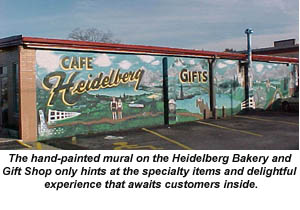
That strategy--irresistible bakery products made from scratch surrounded by unique gifts and hard-to-find food items--has been a winning one for more than 32 years, say owners Juergen and Gabi Jungbauer. From the beginning, when J.J. (as Juergen likes to be called) opened the bakery, he decided to concentrate only on German-style bakery foods and products. "We have never made any donuts or pies," he says. "If customers ask for them, I'd rather send them to a specialty shop."
Instead, J.J. put his skills as a German-trained pastry chef to work in building a bakery that draws customers from all over the city, as well as from other parts of the state, for products that aren't easy to find elsewhere. Some products are classics. For example, his collection of tortes includes the classic Black Forest cake, but one that's made with a Heidelberg twist: a ring of chocolate buttercream encloses the cherry filling, which goes atop a kirshwasser-sprinkled chocolate layer. Baker Debbie Larson speeds up the cake makeup by putting the ring of buttercream atop chocolate layers, then freezes the layers. The following day, she can deposit the cherry filling into the frozen buttercream ring, and can level the filling without smearing the buttercream. The rest of the cake is put together with fresh whipped cream.
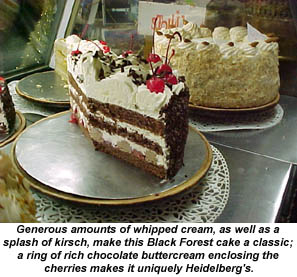
Other products are unique to Heidelberg, including hazelnut "fudge" cakes. The fudge layer is actually similar to a rumball mixture, and is made from cake trimmings that have been extended with chocolate, buttercream, hazelnuts and rum flavor. Debbie forms the mixture into a layer on an 8-in. circle, then deposits it on a prepared cake layer before assembling the rest of the cake using a hazelnut-flavored buttercream between and on top of the cake. "It's a good way to use the extra cake," Debbie says, "and still have something unique for our customers."
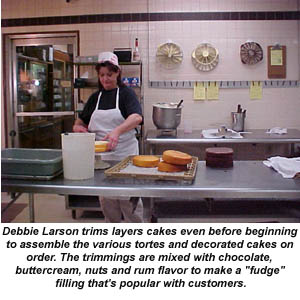
Cafe seating helps to sell bakery foods
Customers can buy whole tortes, but Debbie scores the cake tops so the slices can be portion-controlled. Because cafe tables are scattered throughout the bakery, lots of customers order slices of torte to go with coffee or tea. They also can choose from a selection of different German-style foods. They're listed on a menu that's mounted on a spaetzle board, a small wooden board that resembles a breadboard. "We prefer to stick to items that are hard to find somewhere else," J.J. says. "As a result, we get a lot of lunchtime traffic from business people who want something different. The menu has specialties like bratwurst, mettwurst, kielbasa and kassler rippchen, which we import to keep them authentic." (Mettwurst is a soft, spreadable sausage, and kassler rippchen are smoked pork chops.) Besides enjoying these products at the bakery, customers also can buy them to take home from the bakery's small refrigerated display per rippchen are sold vacuum-packaged.
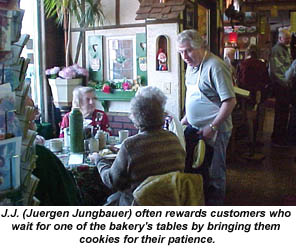
The cooks must envy the room the bakers have, however, since the fairly extensive menu is prepared in a kitchen space that's quite compact. However, the bakers do help out by preparing the hot German potato salad, made by boiling red potatoes, "grating" them roughly on a wire rack and dressing them with a vinegar-and-bacon based mixture.
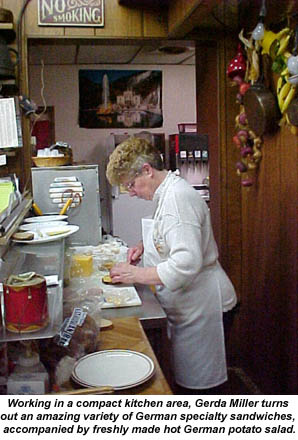
The bakers, who normally are done baking by 10 a.m., provide a variety of breads and rolls that enhance the flavor of the imported sausages. Of course, the bakery carries the selection of products customers expect to see, including Danish, cookies and decorated cakes, as well as breads and rolls. However, J.J. has certain breads delivered from Chicago bakeries to meet demand for products that would be unprofitable to make in small batches. "Some of our customers want dark rye or pumpernickel breads," he says, "so we can give them what they want without affecting our own labor costs and production schedule by buying from other bakers who do a lot of these breads." These breads also are used in preparing a variety of sandwiches carried on the cafe menu. That way, customers have an opportunity to sample the various breads and rolls the bakery offers, whether made from scratch or purchased from other bakeries. "Everything works together here," J.J. says. "The bakery products bring customers into the store, the cafe gives them another reason to come more often, and the gifts make it fun to visit anytime."
Gifts galore make bakery visits fun
J.J. expanded the bakery three times over the years to accommodate his growing business, which from the beginning included counter and table service, as well as imported chocolates and candies. His waitresses used to wear dirndl uniforms to add to the atmosphere of German authenticity. And German music wafted in the background to complete the experience.
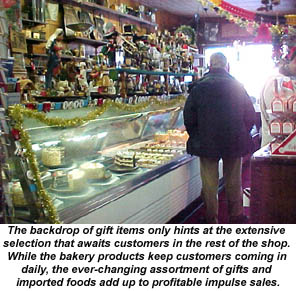
Early on, J.J. began to include gifts. "I got the idea from drug stores," he says. "The small corner drug stores didn't only sell drugs. They also sold the type of products you used to be able to find in a general store. And, when you went into a drug store, you had to go way in the back for them, and you passed all these other things you could buy on the way. So, I decided to do something similar. We always had put the Danish way in the back, so customers had to pass all the candies, cakes and cookies every day. But then we started adding candles, figurines and T-shirts. We started visiting the gift shows, as well as the fancy food shows and concentrated on buying things that only smaller stores carry. For example, we used to buy Toblerone chocolates before the supermarkets started carrying them. But now that every store has it, we prefer to find products that customers can't buy in a supermarket or department store."
To enhance the ambiance, J.J. also created a unique decor for the bakery, inside and out. "I wanted to make it entertaining for customers to visit the bakery, and I also wanted them to learn when they came in," he says. "So, I hired an artist to do murals on the walls that were typical scenes from a bakery or from areas in Germany." Now, there are few square inches in the store that aren't either painted with an amusing scene or stocked with an assortment of foods or gift products. And, because the cafe tables are scattered throughout the store, customers can literally enjoy a different view each time they come in.
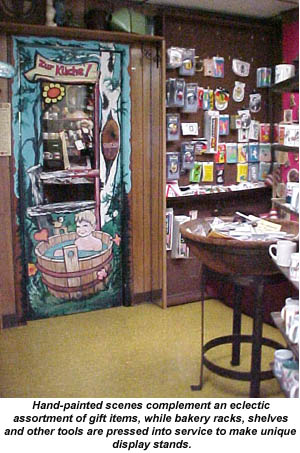
"You might think it's expensive to keep such a large inventory of products," says J.J. "But I look at it as money in the bank. If you keep your money in a savings account, you only earn 2% to 3% interest. But if you buy at item that you can mark up 100%, you've made more money that you could have in that bank account. So, over the years, the gifts have made good business sense for me."
Antique bakery provides a glimpse into the past
J.J. hasn't forgotten his bakery roots. The store's eclectic display includes an "antique" bakery, which also is the focal point of many a school tour. To equip the antique bakery, J.J. bought items at bakery auctions, including an old coal oven, early editions of mixers and a variety of hand tools that preceded modern versions of these labor-saving devices.
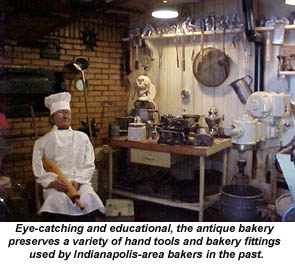
But even here, J.J. maintains a German flavor. His antique bakery exhibit also includes an extensive collection of hand-carved wooden springerle forms. He still uses a variety of the forms to make springerle at Christmas. The springerle dough is pressed into the forms, where the design is embossed onto the dough surface. After unmolding, the dough is allowed to dry overnight before baking. As a result of this process, the springerle designs stay sharp and clear, and the cookies themselves are light and crisp.
Photos really can't do justice to the unique nature of the Heidelberg Bakery Cafe and Gift Shop, which is full of nooks and crannies and delights at every turn. That's what keeps bringing customers back--not only the delicious treats, but also the opportunity to find that special "got to have it" gift.
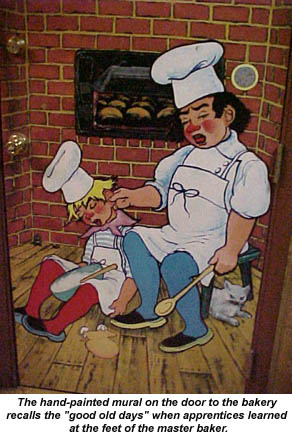
For more information on RBA Marketplace 2001…
• Click here for an overview article on of Marketplace 2001.
• Bakery Online will cover the event, including all RBA bakery tours. This coverage will appear before and during the event in a special "RBA Marketplace 2001" section of our News and Analysis homepage. (See link at left-hand side of this page).
• After the event, just search "RBA Marketplace" or your own favorite keywords on the site to find these stories in our permanent Editorial Archive
• Send e-mail to RBA at attend@rbanet.com; telephone (800) 638-0924 or (301) 725-2149; or click to visit RBA's website. >
Carol Meres Kroskey, baker-editor at Bakery Online, is the award-winning, former senior baker editor of Bakery Production and Marketing magazine. Her baking experience includes stints at various retail, hotel and supermarket bakeries as baker and pastry cook. She also spent several years as an experimental baking technician for the American Institute of Baking and as a test baker at The Long Co., a co-op for independent wholesale bakers. Carol can be reached at carol.kroskey@prodigy.net
